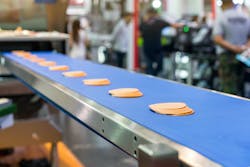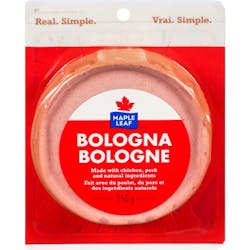Maple Leaf Foods Connects MES to Advanced Analytics
If you follow news around the Industrial Internet of Things (IIoT) or digital transformation, you’ve undoubtedly heard that around 70% of these projects fail to one degree or another. Maple Leaf Foods, Canada’s largest producer of prepared meats, found that by focusing on a specific key performance indicator (KPI), it was able to reduce its expected timeline for a return on investment from one year to three months.
The KPI Maple Leaf Foods focused on was yield via reductions in waste and loss.
In a presentation at Aveva World 2023, Blair Hembruff, president of Cygnus Consulting Inc., the system integrator that worked with Maple Leaf Foods on this project, said, “We initially thought we would put all these IoT sensors in and send their data to the cloud for AI (artificial intelligence) analysis directed at specific yield improvements. But Andy [Andrew Thorne, solutions architect at Maple Leaf Foods] said: ‘Hey, we already have a full MES (manufacturing execution system) in place, do we really need a full IoT implementation?’”
That question led the project team to instead focus on leveraging the MES to access all the plant’s process data and view it in an MES context before sending it to a cloud-based AI system for deeper analysis. In this way, “we can contextualize the process data with manufacturing information in the production orders and the SKUs so that all the information is already prepackaged for us,” said Hembruff.
The process
With MES as the centerpiece of this yield improvement project, Maple Leaf Foods and Cygnus Consulting designed their approach as part of a continuous improvement project. This required Maple Leaf’s continuous process improvement and Six Sigma groups to review the plant’s operations to determine where yield improvements could deliver the biggest benefit. Their findings gave the project team their target—to reduce waste and loss by a certain percentage and translate that percentage into specific financial savings that could be measured through the project.
Armed with these findings, the project team focused on Maple Leaf Foods’ bologna production processes. This production process starts in Maple Leaf Foods’ pickling area where the meat is brined and then ground before being moved to the stuffing area of the plant where the meat is formed into logs, which are then moved into batch cooking areas and then chilling before moving into the plant’s slicing areas.
Hembruff said, “What we were working to do is present the meat in the most consistent way to each process to reduce loss. To do this, the logs must have a consistent width and shape. So, if we can make the logs the same way over and over again so that they go to the cookhouse in the right shape and can be cooked the same amount of time and be presented to the slicers exactly the same way—that feeds all the way through for the yield improvement sought after in this project. It was all about making a consistent product cooked exactly the right amount to minimize yield loss by managing moisture loss during cooking to deliver a log with exactly the right dimensions to the slicers for maximum yield.”
The technologies
The Maple Leaf plant involved in this project was built in 2014 and had Aveva MES as part of the original bill of OT (operations technology) software along with a SCADA system and integration into SAP’s ERP (enterprise resources planning) and production scheduling.
“It was a full end-to-end MES implementation that was integral to the plant operation,” explained Hembruff.
To leverage the plant’s existing technologies, Cygnus Consulting handled the design, engineering, installation and commissioning of the sensors and all the interfaces up to the Braincube AI system which was used to build digital twin models of the plant’s assets using sensor data.
Aveva has long maintained an agnostic approach to its software products, stressing their openness to integration with third-party software products. This Maple Leaf Foods’ project, which involved integration with third-party ERP and AI software, highlights Aveva’s agnostic approach.
In addition to the ERP and AI software integrations, Cognex vision systems were used to measure log dimensions and inform the operators who set up the bologna log stuffing machine. Hembruff noted that a key part of this process was not just about delivering specific bologna log dimensions, it was also about “analyzing the factors that keeps log production consistent. This information was in the MES and could then be sent to Braincube for analysis.”
With the bologna logs now being delivered in consistent dimensions as they move into the cooking process, Hembruff said there are two main data points to manage—oven temperature and meat temperature to ensure that they're completely cooked for food safety.
“If you overcook them, you lose yield from moisture loss,” Hembruff said. “By looking at the temperature data to determine the optimum temperature profile, you know what temperature to use for what duration to make sure you cook the log correctly. Feeding this temperature data up to the digital twin created by Braincube, we were able to come up with optimum recipes for the oven.”
This led to the development of an optimized schedule for the ovens because Maple Leaf Foods now has an exact and repeatable oven recipe. However, the limited amount of operators used to load multiple ovens with products using different recipes would still, on occasion, lead to periods where the bologna logs would stay in the oven too long and overcook. To address this issue, an optimizer application was developed to make sure the ovens were scheduled in an optimal manner using data from the PLCs and temperature probes that were fed through the MES.
Andrew Thorne of Maple Leaf Foods said, in addition to the yield improvements realized through consistent log size production, Maple Leaf Foods was also turning the ovens off earlier and saving power.
Another production area impacted by the technologies used in this project was the bologna slicing process.
Hembruff noted that a meat slicer doesn't sound that complicated and thus likely wouldn’t benefit much from data analysis. But at Maple Leaf Foods’ production scale, these slicers are quite complicated machines with recipes based on what's being produced and the life of the machine.
To develop a golden batch recipe for the slicers, Hembruff said they fed the slicer information through the MES into Braincube’s AI to produce slicer recipes for optimal yield. This information is visible to operators on the shop floor dashboards to show current yield data and highlight trouble points for operators to focus on.
Hembruff added that a great deal of time was also spent on user experience (UX) and user interfaces (UI) for the operators. To get buy in on the shop floor, a clear focus on UX and UI is required, he said.
Speaking about the overall impact of AI on this project, Thorne said, “Using digital twins is a really new era for us. When we asked Braincube about what data science could do for us, they said to throw everything—every single tag out of a slicer—up to us we're going to feed it back to you in a meaningful way. Then they went down to the process data and the MES and added those data and structured it all up in a digital twin. Now they’re pulling those data up every 10 minutes to keep refining and learning. The results are these perfect parameters for specific machines and lines for that day. Once we started setting the machines up this way, we got the perfect batch almost every single time.”
Results
Once Maple Leaf Foods had the complete process, including the slicers, continuously optimized, the “yields went through the roof,” said Thorne. “This led to a 10%-12% increase in gross profit for those lines.”
As a result, Maple Leaf Foods’ ROI on this project—which was originally expected to take a year to achieve—was reached in just three months.
“A lot of projects now have a lot of buzzwords associated with them—like IoT and AI—and many of those IoT projects haven't been as successful as this one,” said Hembruff. “This one was successful because it was always focused on yield.”
He added that another key is leveraging what you have. “Maple Leaf Foods already had a full Aveva MES and we leveraged that as much as we could. It saved a ton of time and money in the implementation because the data in it was already validated. We knew from the start the data we were relying on was correct and that we weren’t adding unnecessary infrastructure.”
You've read the article, and now it's time to test your knowledge. Can you connect MES to advanced analytics?





